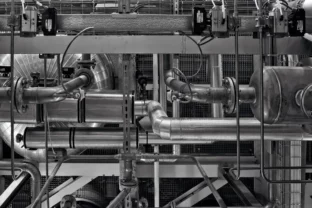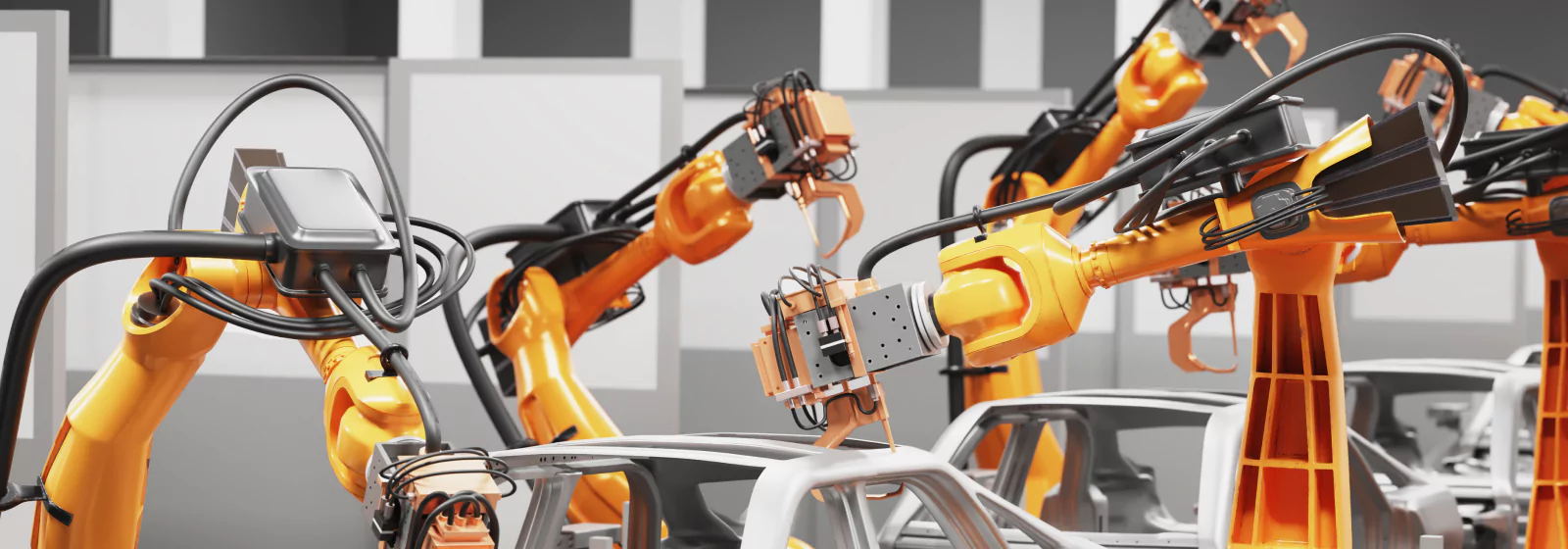
How IoT is transforming the manufacturing industry
Summarize:
Think of a factory where machines communicate with each other and production lines predict maintenance needs before breakdowns. Sounds utopian? That becomes possible with IoT in manufacturing.
The Internet of Things connects sensors, devices, and software into a unified network — completely changing how things operate. Manufacturers get complete visibility of their processes, benefit from automation, and, ultimately, stay more competitive in an increasingly digital world.
The numbers speak for themselves. The global IoT in manufacturing market, valued at $50 billion in 2021, will likely surpass $87 billion in 2026. Growing by 11.9% each year, it’s clear that IoT isn’t just a trend. Instead, it’s a fundamental change for the entire industry.
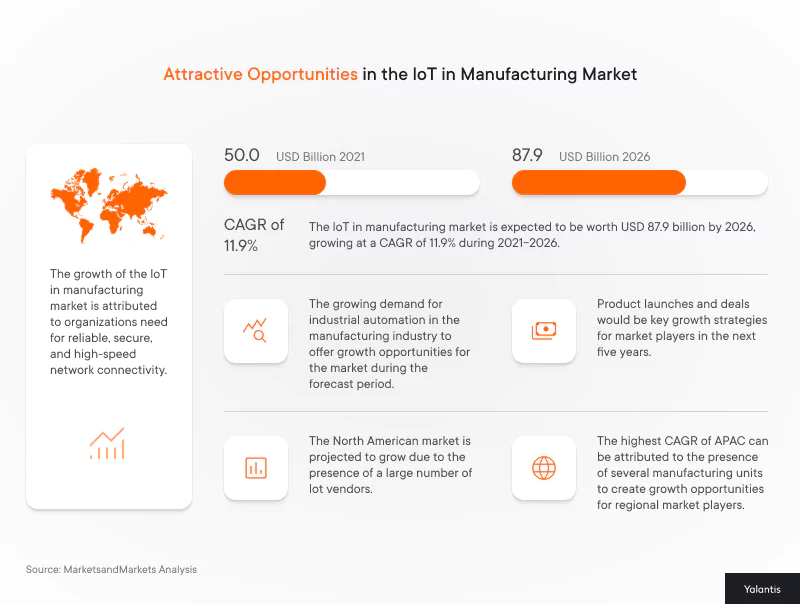
In this article, we’ll explore how IoT transforms manufacturing — including predictive maintenance, quality control, inventory management, and more. Also, we will dive into the tangible advantages it brings.
Key benefits of IoT in manufacturing
Industrial IoT solutions benefit manufacturers in several ways. In particular, they offer efficiency, cost-effectiveness, real-time visibility, automation, and agility. Let’s see how you can achieve these advantages:
- Boost efficiency to new heights. IoT takes manufacturing process efficiency to a whole new level. That’s possible through real-time IoT data analytics and collection and machine-to-machine communication. With these solutions, production lines self-optimize and highlight anomalies for quick resolution.
- Cut costs without cutting corners. Every manufacturer is looking for ways to reduce costs without sacrificing quality. IoT tackles this challenge by lowering maintenance expenses with predictive analytics. It optimizes energy usage with industrial IoT sensors, minimizes waste through real-time tracking, and reduces manual work with automation.
- Access real-time monitoring with IoT for informed decisions. The Internet of Things in manufacturing offers a bird’s-eye view of the entire production line at all times. Sensors placed on machines, conveyor belts, and worker stations provide live data on performance, output, and efficiency. With this level of supply chain visibility, manufacturers spot bottlenecks, ensure quality, and improve workplace safety.
- Automate processes for increased productivity. Although automation in manufacturing isn’t new, IoT significantly enhances it. Instead of manually adjusting settings or responding to issues after they arise, IoT-enabled manufacturing systems automatically optimize workflows.
- Make supply chains more agile. Global supply chains are often unpredictable. Using IoT in factories helps stay ahead with real-time visibility into inventory levels, shipping statuses, and supplier performance. Plus, with connected logistics, manufacturers can predict delays and automate restocking.
Industrial innovation powered by IoT
Transform your operations with smart, connected industrial IoT solutions.
Top 5 manufacturing IoT applications
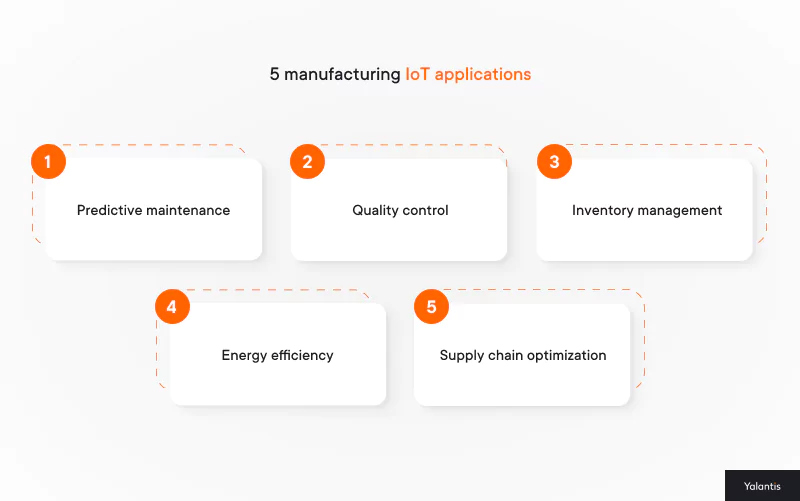
Let’s now explore how IoT works in real-world manufacturing settings. The most common manufacturing IoT applications include predictive maintenance, quality control, inventory management, energy efficiency, and supply chain optimization. Here’s a closer look at each use case:
1. Predictive maintenance
Traditional maintenance strategies fall into two primary categories:
- Scheduled maintenance — fixing machines at set intervals, even if they don’t need it
- Reactive maintenance — fixing them after they break down
Both are typically costly and inefficient.
Predictive maintenance IoT solutions, in turn, constantly monitor temperature, vibration, pressure, and other performance metrics through sensors. Then, manufacturers analyze the obtained data to predict when a component is likely to fail.
For example, we included a predictive maintenance IoT module when building an IoT-based energy consumption monitoring system for our client, a US-based manufacturer. This module used ML algorithms to analyze sensor data, spotting anomalies and energy-saving opportunities.
2. Quality control
Product quality significantly impacts a manufacturer’s reputation. IoT solutions company for manufacturing make quality control precise with real-time monitoring.
How does it work? Sensors and devices (for example, cameras) analyze every production stage, scanning for defects like:
- incorrect dimensions
- surface flaws (scratches, dents, discoloration)
- irregularities in material composition
When a defect is detected, the system automatically flags the issue, pauses production, and adjusts machine settings to correct the problem.
3. Inventory management
Manufacturers don’t only use IoT for production optimization and quality control. It’s also highly efficient for inventory processes. No more overstocks or shortages — all thanks to real-time inventory tracking.
RFID tags and IoT sensors provide up-to-the-minute data on stock levels and automatically update the system when materials are low. It comes with the following opportunities:
- Automate reordering processes to prevent shortages.
- Optimize warehouse space by only storing what’s necessary.
- Reduce waste by tracking expiration dates on perishable materials.
4. Energy efficiency
Optimizing energy usage is one of the most critical manufacturing IoT applications. That’s because energy is a significant expense for manufacturers.
Smart meters and sensors track energy consumption to identify energy-intensive machines and optimize their usage. Moreover, they automatically adjust heating, cooling, and lighting.
For instance, our IoT-based energy consumption monitoring system collects power, current, and voltage sensor data. It transmits this data to the central management hub and alerts users of abnormal power consumption and energy waste. In fact, it helped our client reduce energy consumption by 30% and lower energy costs by 25%, respectively.
5. Supply chain optimization
IoT-driven supply chain optimization keeps every process on track with real-time monitoring and analytics. For example, manufacturers may use GPS-enabled IoT devices to track shipments in real time and monitor environmental conditions (like temperature for perishable goods).
Challenges and solutions in smart manufacturing IoT
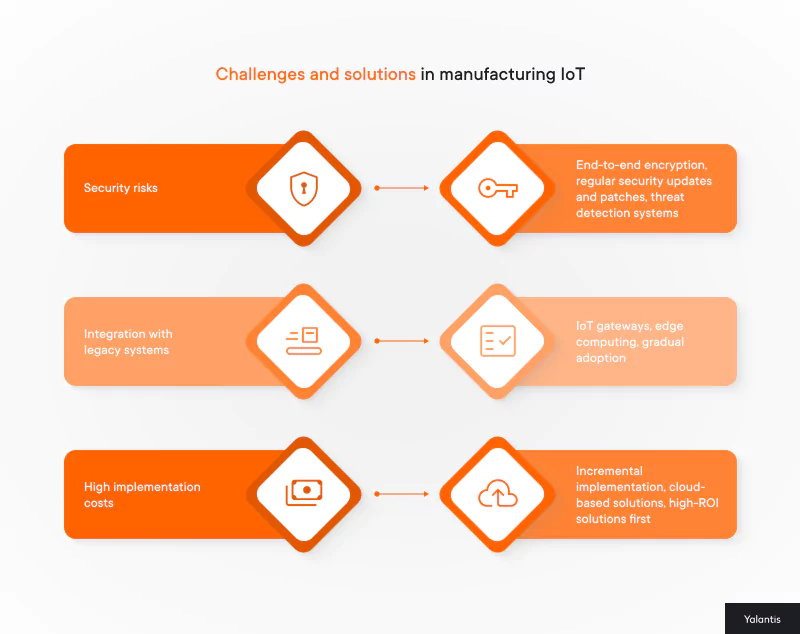
IoT in manufacturing is indeed a game-changer. However, adopting it might be challenging. Security risks, integration issues, and high initial costs sometimes slow down the progress.
The good news? Every challenge has a solution. Let’s explore manufacturers’ biggest obstacles and how to overcome them.
IoT in manufacturing is indeed a game-changer. However, adopting it might be challenging. Security risks, integration issues, and high initial costs sometimes slow down the progress.
The good news? Every challenge has a solution. Let’s explore manufacturers’ biggest obstacles and how to overcome them.
Security risks
With numerous devices in connected factories exchanging data every second, IoT cybersecurity may be concerning. A single vulnerability often becomes an entry point for cybercriminals, putting production data and processes at risk.
The solution:
- Use end-to-end encryption to protect data in transit and at rest.
- Implement regular security updates and patches to remove vulnerabilities.
- Leverage AI-powered threat detection systems to monitor unusual activity.
Integration with legacy systems
Many manufacturers still rely on older, non-digitalized equipment. Implementing the Internet of Things for manufacturing systems that are outdated can be difficult, as older machines weren’t designed to connect to a network.
The solution:
- Use IoT gateways as a bridge between IT and manufacturing systems
- Adopt edge computing for manufacturing to process data locally
- Stick to gradual adoption instead of replacing all machines at once
High implementation costs
Adopting industrial IoT solutions requires an upfront investment in sensors, software, and infrastructure. For small and mid-sized manufacturers, the costs could be overwhelming.
The solution:
- Start small and scale up later.
- Use cloud-based industrial solutions to reduce infrastructure costs.
- Implement high-ROI IoT solutions first.
End-to-end IoT services
Seamless IoT integration starts here.
Market trends in smart manufacturing
The current state of things in the manufacturing industry signals that modernization is no longer an option. Several industry-wide trends contribute to that:
- The rise of hyperautomation. The automation of as many company processes as possible — known as hyperautomation — is reshaping IT for manufacturing. According to Gartner, by 2026, over 30% of enterprises will automate over half of their activities.
- Governments investing in Industry 4.0. Industry 4.0, or the Fourth Industrial Revolution, aimed to digitize the manufacturing sector, is getting significant support from governments worldwide. For example, the European Union’s advanced manufacturing projects under the Factories of the Future and Made in Europe partnerships have already raised €2.2 billion in investments.
- Shift toward sustainability and energy-efficient manufacturing. The industrial sector accounted for nearly 37% of global energy consumption in 2022. No wonder manufacturers are increasingly turning to advanced manufacturing systems to optimize energy use and reduce carbon footprints.
- Cybersecurity threats on the rise. The adoption of industrial IoT for manufacturers grows, and so do security risks. According to a Barracuda survey, 94% of industrial IoT organizations experienced at least one security incident in 2022.
- Industrial IoT market beyond 2026. The global IIoT market will reach over $1.7 trillion by 2030, as Grand View Research suggests. The main growth drivers include the increasing availability of processors and sensors, along with the advancements of IT in the manufacturing industry.
The road ahead: Future trends in smart manufacturing IoT
For factories to become even smarter, there are plenty of emerging techs to embrace. Let’s explore what’s on the horizon.
- Artificial intelligence (AI). AI lets machines learn, adapt, and make their own decisions. With this tech in place, we’re looking into the manufacturing processes involving numerous perks. These include AI-powered predictive maintenance, digital twin technology, generative design, autonomous quality control, and self-optimizing production lines.
- Edge computing. Besides AI and IoT in manufacturing, edge computing will create buzz, too. Since IoT devices in manufacturing generate tons of data, sending everything to the cloud for processing creates delays. With edge computing, data is processed locally. It reduces latency and lowers bandwidth costs.
- Cloud integration. While edge computing deals with data locally, cloud integration stays crucial for big-picture insights and scalability. Using cloud-based industrial solutions, manufacturers will unify data from multiple factories. They will scale IoT systems easily and enable remote monitoring and control.
Speaking of cloud-based solutions, we’ve delivered one for our client, a manufacturer of LoRaWAN-based IoT sensors, meters, and gateways. As part of our cooperation, we moved their outdated, siloed IIoT management system to AWS IoT Core.
How Yalantis can help
Yalantis is a software development company with over fifteen years of experience building powerful industrial IoT solutions. We offer more than just installing sensors and collecting data — we create fully integrated systems that deliver actual value.
Why choose us?
- Our smart factory technology solutions help businesses cut operating costs by 20%.
- We offer one of the largest Rust development teams with 20+ Rust developers.
- We’ve successfully completed 20+ IoT projects across multiple industries, with manufacturing included
What do we offer?
We tackle industrial IoT security challenges and build end-to-end IoT solutions. Our team covers everything from software and firmware development to hardware integration. Plus, we provide assistance with sensor prototyping. As an IoT security company, we also ensure that the security of your IoT systems is robust, addressing vulnerabilities and ensuring safe data transmission across all devices.
If you want to learn more, check out our IoT project portfolio.
Final thoughts
Industrial IoT solutions are already here, transforming the manufacturing industry. Whether it’s predictive maintenance that prevents costly breakdowns or industrial automation with IoT that boosts efficiency, IoT offers smarter, faster, and more cost-effective production.
However, adopting smart manufacturing IoT requires thorough strategy and preparation. If you need a hand with that, count on Yalantis. With over twenty IoT projects completed, we know how to create smart production lines, inventory management, and other solutions. IoT product consulting services can guide you through the entire process, from initial strategy development to full implementation, ensuring your solution is tailored to meet your business objectives.
Smart connectivity for manufacturing
Let’s bring intelligence to your manufacturing operations with IoT.
Rate this article
4.9/5.0
based on 25 reviews


